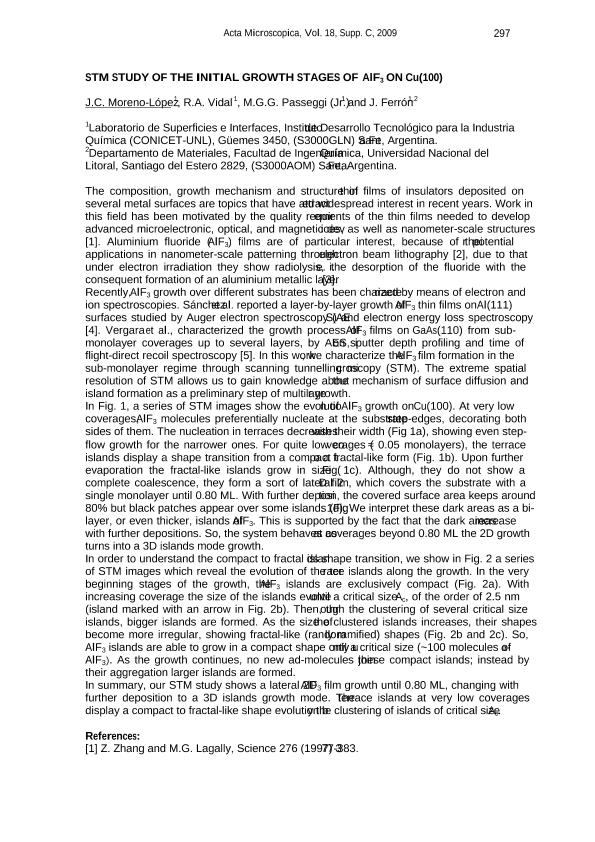Mostrar el registro sencillo del ítem
dc.contributor.author
Moreno López, Juan Carlos

dc.contributor.author
Vidal, Ricardo Alberto

dc.contributor.author
Passeggi, Mario Cesar Guillermo

dc.contributor.author
Ferron, Julio

dc.date.available
2017-09-29T17:20:11Z
dc.date.issued
2009-10
dc.identifier.citation
Moreno López, Juan Carlos; Vidal, Ricardo Alberto; Passeggi, Mario Cesar Guillermo; Ferron, Julio; STM study of the initial growth stages of AlF3 on Cu(100); Comité Interamericano de Sociedades de Microscopía Electrónica; Acta Microscopica; 18; Supp C.; 10-2009; 297-298
dc.identifier.issn
0798-4545
dc.identifier.uri
http://hdl.handle.net/11336/25438
dc.description.abstract
The composition, growth mechanism and structure of thin films of insulators deposited on several metal surfaces are topics that have attracted widespread interest in recent years. Work in this field has been motivated by the quality requirements of the thin films needed to develop advanced microelectronic, optical, and magnetic devices, as well as nanometer-scale structures [1]. Aluminium fluoride (AlF3) films are of particular interest, because of their potential applications in nanometer-scale patterning through electron beam lithography [2], due to that under electron irradiation they show radiolysis, i.e. the desorption of the fluoride with the consequent formation of an aluminium metallic layer [3]. Recently, AlF3 growth over different substrates has been characterized by means of electron and ion spectroscopies. Sánchez et al. reported a layer-by-layer growth of AlF3 thin films on Al(111) surfaces studied by Auger electron spectroscopy (AES) and electron energy loss spectroscopy [4]. Vergara et al., characterized the growth process of AlF3 films on GaAs(110) from submonolayer coverages up to several layers, by AES, ion sputter depth profiling and time of flight-direct recoil spectroscopy [5]. In this work, we characterize the AlF3 film formation in the sub-monolayer regime through scanning tunnelling microscopy (STM). The extreme spatial resolution of STM allows us to gain knowledge about the mechanism of surface diffusion and island formation as a preliminary step of multilayer growth. In Fig. 1, a series of STM images show the evolution of AlF3 growth on Cu(100). At very low coverages, AlF3 molecules preferentially nucleate at the substrate step-edges, decorating both sides of them. The nucleation in terraces decreases with their width (Fig 1a), showing even stepflow growth for the narrower ones. For quite low coverages (» 0.05 monolayers), the terrace islands display a shape transition from a compact to a fractal-like form (Fig. 1b). Upon further evaporation the fractal-like islands grow in size (Fig 1c). Although, they do not show a complete coalescence, they form a sort of lateral 2D film, which covers the substrate with a single monolayer until 0.80 ML. With further deposition, the covered surface area keeps around 80% but black patches appear over some islands (Fig. 1d). We interpret these dark areas as a bilayer, or even thicker, islands of AlF3. This is supported by the fact that the dark areas increase with further depositions. So, the system behaves as at coverages beyond 0.80 ML the 2D growth turns into a 3D islands mode growth. In order to understand the compact to fractal islands shape transition, we show in Fig. 2 a series of STM images which reveal the evolution of the terrace islands along the growth. In the very beginning stages of the growth, the AlF3 islands are exclusively compact (Fig. 2a). With increasing coverage the size of the islands evolve until a critical size Ac, of the order of 2.5 nm (island marked with an arrow in Fig. 2b). Then, through the clustering of several critical size islands, bigger islands are formed. As the size of the clustered islands increases, their shapes become more irregular, showing fractal-like (randomly ramified) shapes (Fig. 2b and 2c). So, AlF3 islands are able to grow in a compact shape only until a critical size (~100 molecules of a- AlF3). As the growth continues, no new ad-molecules join these compact islands; instead by their aggregation larger islands are formed. In summary, our STM study shows a lateral 2D AlF3 film growth until 0.80 ML, changing with further deposition to a 3D islands growth mode. The terrace islands at very low coverages display a compact to fractal-like shape evolution by the clustering of islands of critical size Ac.
dc.format
application/pdf
dc.language.iso
eng
dc.publisher
Comité Interamericano de Sociedades de Microscopía Electrónica
dc.rights
info:eu-repo/semantics/openAccess
dc.rights.uri
https://creativecommons.org/licenses/by-nc-sa/2.5/ar/
dc.subject
Aluminium Fluoride
dc.subject
Copper
dc.subject
Thin Films Growth
dc.subject
Scanning Tunneling Microscopy
dc.subject.classification
Otras Ciencias Físicas

dc.subject.classification
Ciencias Físicas

dc.subject.classification
CIENCIAS NATURALES Y EXACTAS

dc.title
STM study of the initial growth stages of AlF3 on Cu(100)
dc.type
info:eu-repo/semantics/article
dc.type
info:ar-repo/semantics/artículo
dc.type
info:eu-repo/semantics/publishedVersion
dc.date.updated
2017-09-25T18:22:13Z
dc.journal.volume
18
dc.journal.number
Supp C.
dc.journal.pagination
297-298
dc.journal.pais
Venezuela

dc.journal.ciudad
Caracas
dc.description.fil
Fil: Moreno López, Juan Carlos. Consejo Nacional de Investigaciones Científicas y Técnicas. Centro Científico Tecnológico Conicet - Santa Fe. Instituto de Desarrollo Tecnológico para la Industria Química. Universidad Nacional del Litoral. Instituto de Desarrollo Tecnológico para la Industria Química; Argentina
dc.description.fil
Fil: Vidal, Ricardo Alberto. Consejo Nacional de Investigaciones Científicas y Técnicas. Centro Científico Tecnológico Conicet - Santa Fe. Instituto de Desarrollo Tecnológico para la Industria Química. Universidad Nacional del Litoral. Instituto de Desarrollo Tecnológico para la Industria Química; Argentina
dc.description.fil
Fil: Passeggi, Mario Cesar Guillermo. Consejo Nacional de Investigaciones Científicas y Técnicas. Centro Científico Tecnológico Conicet - Santa Fe. Instituto de Desarrollo Tecnológico para la Industria Química. Universidad Nacional del Litoral. Instituto de Desarrollo Tecnológico para la Industria Química; Argentina
dc.description.fil
Fil: Ferron, Julio. Consejo Nacional de Investigaciones Científicas y Técnicas. Centro Científico Tecnológico Conicet - Santa Fe. Instituto de Desarrollo Tecnológico para la Industria Química. Universidad Nacional del Litoral. Instituto de Desarrollo Tecnológico para la Industria Química; Argentina
dc.journal.title
Acta Microscopica

Archivos asociados
